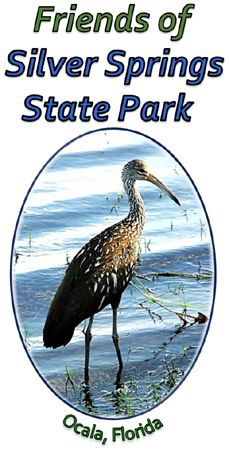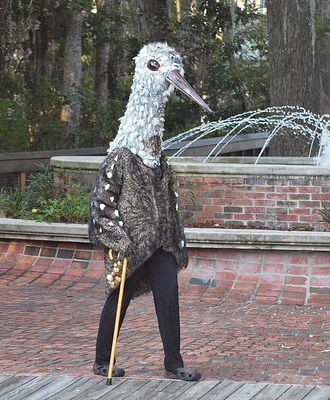
What's your favorite animal? For some people, it's probably a beloved pet, such as a dog, cat, parrot or horse. But what if you aren't into a single "personal" preference? Maybe the individual animal is not the focus, but the species. I have a friend who has a small collection of artworks featuring roadrunners, while another is particularly keen on seeing that same bird out in the wild, to the point that we joke about it being the ultimate goal of every birding expedition around Austin. The armadillo is unique and peculiar enough to be rather high on the list of special beasts. As a kid, I found turtles to be curiously captivating. Television and movies have played a big role in popularizing certain animals. How about Bambi, meerkats, clownfish and insurance-promoting geckos?

After moving to Ocala, Florida, in 1992, my mother, Evelyn, fell in love with limpkins. A good number of people don't even know what that is, but with such a quirky name, it just HAS to be special. The sole member of the family Aramidae, the limpkin (Aramus guarauna) is a rather large wading bird that ranges from the West Indies to Argentina. In the U.S., it lives only in Florida, where it can be found in freshwater habitats that support its favorite food: the Florida apple snail.
The limpkin looks something like a big brown ibis with white spots. Its eyes are soulfully large and its beak curves gracefully downward to function as the perfect snail-extraction tool. Both Evelyn and I have our limpkin encounters on the Silver River, a crystal waterway in Ocala that supports multiple nesting pairs of the birds. While the animal itself is sleek, elegant and classy looking, its voice is not. The repeated screechy, strident, Banshee-like screams are evocative of a primordial jungle and certainly add an air of authenticity to the area that was used as the original setting for the first Tarzan movies.
Because the limpkin is only found where its escargot diet lives, populations are fairly localized. If the snails vanish, so does the bird. This actually happened at Wakulla Springs, near Tallahassee. Like other large springs found in the state, Wakulla once boasted clear waters, Florida apple snails and, of course, limpkins. One of the state park tour boats was even named after the iconic avian resident. Now, though, the water is often not clear, invasive larger species of apple snails have outcompeted the natives, and limpkins have disappeared. Nobody really knows how all these factors are interconnected, but the current state of affairs is obvious, as well as a bit sad.
During the past 25 years, Ev has often kayaked on the Silver River, watching the alligators, birds and monkeys (another leftover from those old Tarzan film days). She knows where the limpkins nest and where they like to hunt snails. She watches them, photographs them, and sometimes even talks to them. One of her limpkin images graces the front of the Silver Springs State Park t-shirts sold in the ranger station as well as the logo for the Friends organization. As a volunteer at the park,  Evelyn often participates in special events, where she helps to promote ecological awareness and educate the public about the wildlife found around the springs and river. Some time ago, she decided to make a limpkin costume, and spent the next two years designing and executing her idea. Through much trial and error, she figured out everything from the big eyes (plastic spoons) to the unique plumage (shaggy brown fake fur fabric with white turkey feather spots). Carrying a cluster of apple snail shells strung on a cord, the Big Bird-like limpkin character debuted during the Critter Trail 5K held at the state park in November, 2016. The walking cane is not an authentic limpkin accessory, but it was necessary for Evelyn, who donned the outfit, to maintain stability under the towering, long-billed model.
Evelyn often participates in special events, where she helps to promote ecological awareness and educate the public about the wildlife found around the springs and river. Some time ago, she decided to make a limpkin costume, and spent the next two years designing and executing her idea. Through much trial and error, she figured out everything from the big eyes (plastic spoons) to the unique plumage (shaggy brown fake fur fabric with white turkey feather spots). Carrying a cluster of apple snail shells strung on a cord, the Big Bird-like limpkin character debuted during the Critter Trail 5K held at the state park in November, 2016. The walking cane is not an authentic limpkin accessory, but it was necessary for Evelyn, who donned the outfit, to maintain stability under the towering, long-billed model.
I was recently in Florida for a visit and my mom and I spent a day kayaking on the Silver River. The wildlife live up to expectations, with photo-op sightings of monkeys, reptiles, and many kinds of birds. While a mother alligator with babies sunning themselves on a log, a snake curled up on the shore, and families of moorhens trotting on the floating vegetation were all memorable, the best encounter was with a limpkin. I spotted the bird perched on the shoreline cypress knees and paddled closer to take pictures. As I drifted in the current, my boat came to rest against a log about five feet away. I had to take care not to bump the animal with my paddle! Instead of the expected flight and alarm calls, this individual just stood there and watched me. In less than a minute, it seemed bored and started to preen. As I steadied my boat in the current, it then stepped down to the water and started looking for snails. Evelyn was a fair distance away, but saw the reason I'd stopped. In our subsequent conversation, she pointed out that the limpkin was so indifferent to my presence because I was wearing a white hat much like hers, as well as using her blue kayak that the birds have come to recognize. Traveling to distant locations to view wildlife is always fun, but sometimes the best episodes occur in familiar territory where we know the local fauna and, better yet, the fauna knows us!